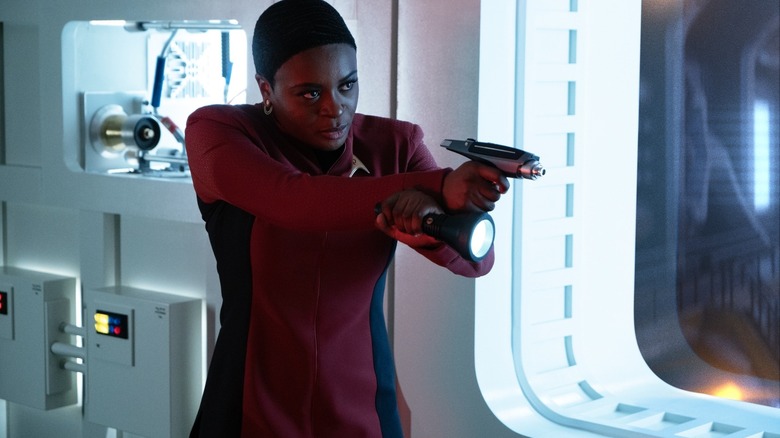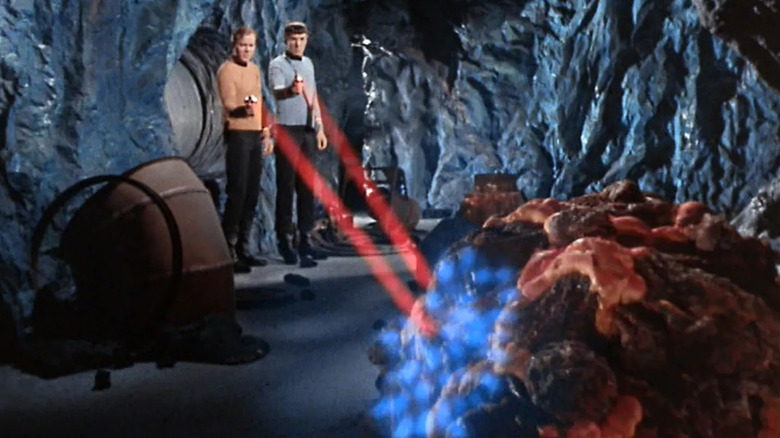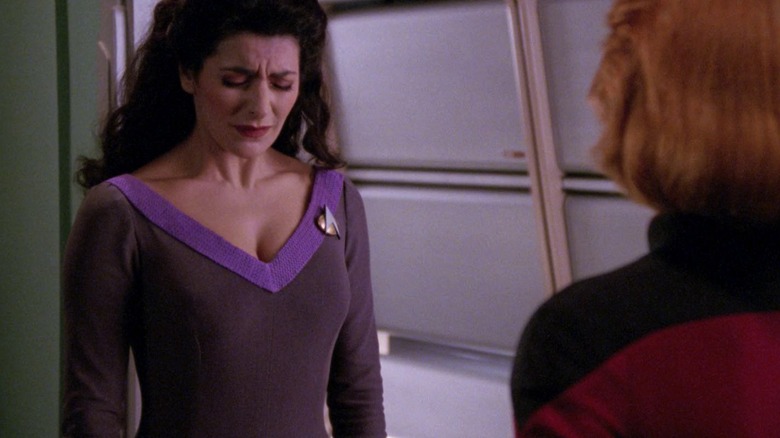Strange New Worlds Finally Breaks Out One Of The Classic Star Trek Episode Templates
This post contains spoilers for the latest episode of "Star Trek: Strange New Worlds."
In "Lost in Translation," the latest episode of "Star Trek: Strange New Worlds," Ensign Uhura (Celia Rose Gooding) hears mysterious noises in her head, and begins experiencing dark, violent hallucinations. She sees haunted house-style hallways wherein all of her comrades were murdered in a bloody fashion, as well as the rotting, desiccated zombie of her late friend Hemmer (Bruce Horak). When looking at scans of her own brain in sickbay, Uhura learns that her language centers are being attacked by a mysterious psychic force somewhere out there in the dead of space.
Uhura, with the help of a brainstorming session with Samuel Kirk (Dan Jeannotte) and the visiting James T. Kirk (Paul Wesley), surmises that her psychic visions aren't attacks, but an oblique form of communication. Uhura is able to "translate" the visions, and discovers that the Enterprise is unwittingly doing harm to an unseen species of psychic, noncorporeal aliens that live inside the materials the ship just happens to be harvesting. The aliens communicate through visions and have been projecting them into nearby humans' brains. It's only after destroying the Enterprise's mining apparatus that the unseen aliens will survive and Uhura's hallucinations will stop.
Noncorporeal aliens are, of course, not new to "Star Trek." Indeed, there were noncorporeal aliens in last week's episode of "Strange New Worlds." Also not new to Trek are stories of unseen or misunderstood alien species that initially do harm to the Enterprise and/or its crew, but end up being innocent creatures merely protecting their domain. "Star Trek" is all about protecting life, so many of its monsters are presented as sympathetic or innocent.
Here are some other examples:.
Devil in the Dark & Home Soil
In "The Devil in the Dark" (March 9, 1967), Kirk (William Shatner) and his crew arrive at a mining colony on the planet Janus VI where the miners are extracting a material called pergium. Miners have been getting killed by a mysterious entity that can, using organic acids, tunnel through the rock with ease. Later in the episode, Kirk and Co. encounter a blob-like being called a Horta that has been attacking the humans in the mine. Kirk corners the injured Horta, but it doesn't attack. Indeed, it burns a message in the rock: "NO KILL I." The captain surmises that the Horta is an intelligent being and that the spherical stones littering the mine are in fact its many, many eggs. The miners invaded her nest and she was defending herself. The miners became aware of the Horta and mined for ore elsewhere.
Something similar happened in the "Star Trek: The Next Generation" episode "Home Soil" (February 22, 1988). The Enterprise-D visits a planet called Velara III, which is in the midst of a very-behind-schedule terraforming project. It seems that the mining equipment is spontaneously rewriting itself and attacking the terraformers. While investigating, Picard (Patrick Stewart) finds a tiny glowing crystal, no bigger than a pebble, that pulsates in a language-like fashion. The Enterprise crew discovers that the crystals are indeed lifeforms. Picard is able to translate their language, and gets to know them. The crystal beings explain in a halting fashion that the terraformers wrecked their home and that they want revenge. Picard, even the diplomat, explains that it was all a misunderstanding and the crystal aliens will be left alone.
The Loss, Species 10-C
"The Loss" (December 31, 1990) isn't so much about intelligent aliens, but the premise is similar. The Enterprise-D finds itself being pulled along through space toward a colossal negative space wedgie that will rip it to shreds. Through careful scans, the Enterprise finds that they are caught up in a swarm of near-two-dimensional alien creatures that their scans are unable to detect. The Enterprise eventually has to project a false negative space wedgie to distract the 2-D aliens and break out of their swarm. The similarities "The Loss" has to "Lost in Translation" also extend to the psychic effect the aliens have on one member of the crew. Deanna Troi (Marina Sirtis) temporarily loses her ability to psychically read the emotions of others.
"Star Trek: Discovery" notoriously pulled the "cataclysm was caused by an innocent species a long ways away" canard twice. At the end of the show's third season, it was revealed that a galaxy-wide disaster called The Burn — a disaster that caused thousands of starships to spontaneously explode — was caused by a fearful Kelpien child hidden in a meteor that amplified his psychic distress. The boy was rescued and the day was saved.
At the end of the fourth season of "Discovery," a similar cataclysm shook the galaxy, this time in the form of destructive gravity wells. By the end of the season, the U.S.S. Discovery finds that the wells are being formed by a massive machine built by the mysterious and newly discovered Species 10-C. The Species (looking like the Heptapods from "Arrival") built the machine as a means of protecting their planet and didn't know it was creating destructive gravity wells. Michael Burnham (Sonequa Martin-Green) was able to explain the situation to them. All was well in the end.


